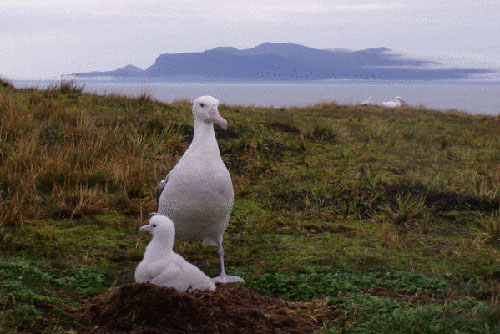Book Review: Marion and Prince Edward: Africa's Southern Islands, by Aleks Terauds, John Cooper, Steven L. Chown and Peter Ryan, published by SUN PReSS, Stellenbosch 7600, South Africa. ISBN: 978-1-920338-42-8, hard-cover with dust-jacket, full colour throughout its 176 pages.
It was a pleasure to review this beautiful book. Although the focus of this review is ACAP-listed species, one cannot avoid perusing the entire book and we include some general comments.
Basic features: the book is divided into six chapters, each of which has several subdivisions. After the dedication, technical pages, table of contents and acknowledgements, the scene is set for readers with an obligatory Introduction. From here the flow of chapters moves from the physical environment to human history, flora, fauna, and closes with the authors' views on various aspects of the islands' future. There follows a very abridged ‘Further Reading' and a somewhat eclectic selection of eight bibliographic references. The book ends usefully with an Index, and list of photographic credits that are not given in the text. The back, inner fold of the dust jacket gives a short biography of the authors.
What immediately captivates is the excellent quality and size of the images, portraying the islands as seen today and taken by superb photographers. One is hard-pressed to find a single page lacking vibrant imagery. Of more subtle and very beautiful detail are the illustrations by Elizabeth Poulsom, at the beginning of chapters and scattered throughout the book. The layout is pleasingly constructed with eye-catching fonts and textured, colour backgrounds to text pages for each new chapter and used judiciously throughout the book to break the monotony of black text on white background. Each chapter is introduced on a double page with a large scenic image on one side and an almost poetic synthesis of what lies ahead on the other. The book is a feast for the eyes.
The text is factual and in some places a bit too technical or "jargonized". Considering the volumes of scientific literature on the islands, the authors have produced a highly informative, but easy read. It's no mean feat to produce entertaining reading, of what may, to some, seem rather dry subjects such as soils, a flora with a scarcity of showy flowers or a landscape dominated by browns and greens.

The chapter "Abundance of animal life" has two sections dealing with ACAP-listed species, but also covers other birds, all marine mammals, and the impact of invasive fauna on the islands. The imagery is dominated by portraits of birds on land, but does justice to their habits, habitats and beauty. Nine ACAP species (five albatrosses and four petrels) breed on the Prince Edward Islands. The albatrosses are dealt with by genus, starting with the Wandering Albatross Diomedea exulans, the two Phoebetria species and then the two Thalassarche species. Each account runs through some basics of the biology, descriptions of key physical characteristics, and their approximate distributions on the two islands. Readers are given population estimates that are usefully put into a global context. The details are as factually accurate and digestible as a coffee-table book should be, although a slightly jarring feature was the choice of the slightly dated common names for the sooty albatrosses. The popular appeal of the albatrosses is tacitly acknowledged when one compares the short shrift given to the dozen other procellariiforms. In all fairness, however, the invariability of their life-history traits (or our lack of understanding thereof), absence of good population estimates and general paucity of facts that might interest the non-specialist make their condensed treatment entirely rational. The focus is rather on the impacts that feral cats (now removed) once had on the burrowing petrels and on Marion Island's ecosystem.
In summary the book is a glorious celebration of two extraordinary islands and their astonishing biodiversity. For laypeople with a continental perspective, it will provide an inspirational glimpse of this atypical ‘African' environment. It is a must-have for those with a fascination for islands, a connection with the Southern Ocean or a passion for albatrosses and petrels and their breeding islands!
Andrea Angel and Ross M. Wanless, 16 December 2010

 English
English  Français
Français  Español
Español